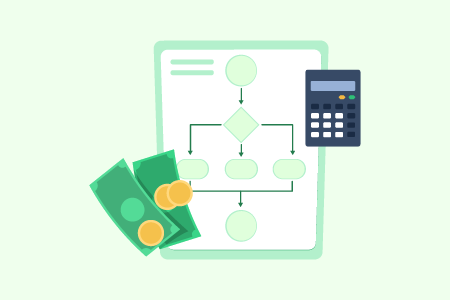Top Financial Modeling Interview Questions
We have all come across the interviews which have made us anxious. The reason for it could be nervousness, insufficient research on the topic, or something else. However, if you are prepared well for an interview, you will be less nervous and will be able to ace it with ease.
In this blog, we have listed the most common financial modeling interview questions for freshers, intermediate, and advanced financial modelers. Along with the questions, with a clear understanding of financial modeling and the types of financial models, and accurate upskilling through financial modeling courses one can easily grab the opportunities and build their career.
Financial Modeling Interview Questions for Freshers
A Fresher financial modeler role involves developing skills and gaining experience in financial modeling, which entails creating detailed financial projections and analyzing financial data in order to make informed business decisions.
Here is a list of financial modeling interview questions for freshers:
1. What is financial modeling, and why is it important?
Financial modeling is the process of creating a mathematical representation of a company’s financial situation. It is important because it allows businesses to make informed decisions and forecast future financial performance.
2. What are the key components of a financial model?
The key components of a financial model include income statements, balance sheets, cash flow statements, and supporting schedules.
3. What is a three-statement financial model?
A three-statement financial model is a model that includes the income statement, balance sheet, and cash flow statement. It is used to project a company’s financial performance over a given period.
4. What is sensitivity analysis, and why is it important?
Sensitivity analysis is the process of examining how changes in inputs affect the output of a financial model. It is important because it helps to identify key drivers of a company’s financial performance and their impact on the overall model.
5. How do you calculate free cash flow?
Free cash flow is calculated by subtracting capital expenditures from operating cash flow.
6. What is the difference between NPV and IRR?
NPV (Net Present Value) is the difference between the present value of cash inflows and the present value of cash outflows. IRR (Internal Rate of Return) is the rate at which the net present value of a project’s cash flows equals zero.
7. What is the purpose of a financial model’s assumptions section?
The assumptions section of a financial model is used to document the key assumptions that underpin the model’s calculations. It is important because it allows others to understand the basis for the model’s projections.
8. What is a discounted cash flow (DCF) analysis, and how is it used?
A discounted cash flow analysis is a method of valuing a company by estimating the present value of its future cash flows. It is used to determine the intrinsic value of a company and to make investment decisions.
9. What are the benefits of financial modeling?
Financial modeling allows businesses to make informed decisions, forecast future financial performance, and evaluate investment opportunities. It can also help identify potential risks and opportunities.
10. What are the limitations of financial modeling?
Financial modeling is subject to assumptions and uncertainties, which can affect the accuracy of its projections. It also relies on historical data, which may not accurately reflect future performance.
11. What is the difference between a pro forma and a historical financial statement?
A pro forma financial statement is a projection of future financial performance, while a historical financial statement shows a company’s actual financial performance over a given period.
12. What is scenario analysis, and how is it used in financial modeling?
Scenario analysis is the process of examining how different scenarios can affect a company’s financial performance. It is used in financial modeling to evaluate the impact of potential risks and opportunities.
13. How do you calculate a company’s cost of capital?
A company’s cost of capital is calculated by taking the weighted average of its cost of debt and cost of equity.
14. What is working capital, and why is it important?
Working capital is the difference between a company’s current assets and current liabilities. It is important because it represents a company’s ability to meet short-term financial obligations.
15. How do you calculate the terminal value of a company?
The terminal value of a company is calculated by estimating its future cash flows beyond the projection period and discounting them to their present value using a terminal growth rate.
Interview Questions for Intermediate Professionals
Intermediate Financial Modellers have 1-5 years of expertise in financial modeling. They have a rudimentary comprehension of financial statements and have created various financial models. Here is a list of interview questions:
16. How do you forecast revenue growth in a financial model?
Revenue growth can be forecasted by analyzing historical trends, market research, and industry growth rates. It can also be influenced by factors such as changes in pricing strategy, product mix, and customer behavior.
17. What are the most common valuation methods used in financial modeling?
The most common valuation methods used in financial modeling include discounted cash flow analysis, comparable company analysis, and precedent transaction analysis.
18. How do you determine the appropriate discount rate to use in a discounted cash flow analysis?
The appropriate discount rate is determined by assessing the risk associated with the investment and adding a premium to account for the time value of money. The risk premium is based on factors such as the company’s industry, size, and financial stability.
19. What are some common errors to avoid when building a financial model?
Common errors to avoid when building a financial model include using incorrect formulas, failing to update assumptions and inputs, and ignoring potential risks and uncertainties.
20. How do you incorporate seasonality into a financial model?
Seasonality can be incorporated into a financial model by analyzing historical trends, identifying seasonal patterns, and adjusting projections accordingly.
21. What is a leveraged buyout (LBO), and how is it modeled?
A leveraged buyout is a financial transaction in which a company is acquired using a significant amount of debt. It is modeled by projecting future cash flows and estimating the amount of debt that can be supported by those cash flows.
22. How do you calculate the weighted average cost of capital (WACC)?
WACC is calculated by taking the weighted average of a company’s cost of debt and cost of equity, where the weights are based on the proportion of debt and equity in the company’s capital structure.
23. What is a sensitivity analysis tornado chart, and how is it used?
A sensitivity analysis tornado chart is a visual representation of the impact of changing key assumptions on a financial model’s output. It is used to identify the most important drivers of a company’s financial performance.
24. How do you incorporate inflation into a financial model?
Inflation can be incorporated into a financial model by adjusting assumptions and projections for changes in the consumer price index or other inflation metrics.
25. What is the difference between cash flow and profit?
Cash flow represents the actual cash that is received or paid out by a company, while profit represents the difference between revenues and expenses.
26. How do you model working capital in a financial model?
Working capital can be modeled by projecting accounts receivable, accounts payable, and inventory levels based on historical trends and assumptions about future sales and payment cycles.
27. What is a waterfall chart, and how is it used in financial modeling?
A waterfall chart is a visual representation of the flow of funds in a financial model. It is used to show how various components of a company’s financial statements contribute to overall financial performance.
28. What is sensitivity analysis, and how is it used in financial modeling?
Sensitivity analysis is the process of examining how changes in inputs affect the output of a financial model. It is used to identify the key drivers of a company’s financial performance and their impact on the overall model.
29. How do you model debt and interest payments in a financial model?
Debt and interest payments can be modeled by projecting the amount of debt outstanding, the interest rate, and the payment schedule. It is important to consider factors such as changes in interest rates and potential refinancing opportunities.
30. What is a Monte Carlo simulation, and how is it used in financial modeling?
A Monte Carlo simulation is a technique used to model the probability distribution of a set of variables.
Interview Questions for Advanced Professionals
Advanced Level Modellers have more than 5 years of experience. They have a thorough grasp of financial statements, and sophisticated modeling methodologies, and have constructed complicated financial models for a variety of companies and purposes. Here is a list of questions:
31. How do you model complex financial instruments, such as derivatives, in a financial model?
Modeling complex financial instruments requires a thorough understanding of the instrument’s mechanics, as well as an understanding of the underlying market factors that affect its value. Advanced techniques, such as the Black-Scholes model and Monte Carlo simulations, may be used to model these instruments.
32. What are some advanced forecasting techniques you have used in financial modeling?
Advanced forecasting techniques include regression analysis, time-series analysis, and machine learning algorithms such as neural networks.
33. How do you incorporate non-financial factors, such as macroeconomic variables and geopolitical risks, into a financial model?
Non-financial factors can be incorporated into a financial model through scenario analysis and stress testing. Advanced models may use econometric techniques to analyze the relationship between economic variables and financial performance.
34. How do you model intangible assets, such as intellectual property and goodwill, in a financial model?
Intangible assets can be modeled using various methods, including the multi-period excess earnings method, the substitute for royalty method, and the greenfield method.
35. What are some advanced techniques for analyzing a company’s financial statements?
Advanced techniques for analyzing financial statements include ratio analysis, DuPont analysis, and common-size analysis.
36. How do you model mergers and acquisitions in a financial model?
Modeling mergers and acquisitions require an understanding of the valuation methods used in the transaction, as well as the potential synergies that may arise from the merger. Advanced techniques, such as merger simulation models, may be used to model the impact of the transaction on the company’s financial performance.
37. How do you incorporate taxes into a financial model?
Taxes can be incorporated into a financial model through the use of tax rates, tax credits, and tax loss carryforwards. Advanced models may use tax optimization strategies to minimize the company’s tax liability.
38. What is scenario analysis, and how is it used in financial modeling?
Scenario analysis is the process of examining the impact of different scenarios on a financial model’s output. Advanced models may use Monte Carlo simulations or other techniques to analyze multiple scenarios simultaneously.
39. How do you model foreign currency exchange rates in a financial model?
Foreign currency exchange rates can be modeled using various techniques, including the forward rate method, the interest rate parity method, and the purchasing power parity method.
40. How do you account for inflation in a financial model?
Inflation can be accounted for in a financial model by adjusting cash flows and discount rates for changes in inflation rates. Advanced models may use inflation-linked securities or inflation swaps to hedge against inflation risk.
41. What are some advanced techniques for building financial models that are robust and flexible?
Advanced techniques for building robust and flexible financial models include using modular design, automated data feeds, and dynamic formulas that adjust to changes in input data.
42. What is a Monte Carlo simulation, and how is it used in financial modeling?
A Monte Carlo simulation is a technique used to model the probability distribution of a set of variables. Advanced models may use Monte Carlo simulations to analyze complex financial scenarios with multiple variables and uncertain outcomes.
43. How do you model complex capital structures, such as those with multiple debt instruments and equity classes?
Modeling complex capital structures requires an understanding of the different debt and equity instruments used in the company’s financing, as well as the rights and obligations associated with each class. Advanced models may use waterfall analyses and other techniques to model the distribution of cash flows to different stakeholders.
44. What are some advanced techniques for stress testing a financial model?
Advanced techniques for stress testing a financial model include scenario analysis, sensitivity analysis, and stress tests that simulate extreme market conditions.
General Questions for a Financial Modeling interview
Here is the list of general questions for the financial modeling interview:
45. List the differences between debt financing and equity financing.
| Debt Financing | Equity Financing |
| Retain the full ownership Interest is tax-deductible More cash in hand No obligations once the debt is paid Must repay in future Requires collateral Can make independent decisions | Shared ownership Dividends are not tax-deductible Investor network will bring credibility No need to repay No worries about immediate ROI Investor returns may exceed debt payments Investor decisions may come the way |
46. Why is it necessary to value a company?
It is crucial to know what the company is worth and the importance of a proper valuation cannot be underestimated. Whether it is making an IPO, considering joint ventures, thinking about venture capitalism, or simply buying & selling shares, financial modeling and valuation is a necessity.
47. Define sensitivity analysis.
This refers to the process of testing the model on various outcomes and preparing well in advance if assumptions don’t come out as planned. The mentioned analysis tests the model based on its strengths and checks if it is capable of incorporating uncertainties over time.
48. How can financial modeling help you?
After exploring the depths of financial modeling you’ll find yourself making better financial decisions. Except for the very fact, that new opportunities will open up for you. All in all, you’ll find yourself in a better position than where you’re right now. Whether it is getting started, acing the hiring process, or getting ahead at your job. Financial modeling has a wide scope.
49. Is financial modeling only for big companies?
Financial models have multiple benefits for larger companies as well as startups. A startup founder may use financial models to present a detailed business plan to investors and significantly increase their chances to receive funding. This is because a financial model helps in projecting clarity and follows a clear logic irrespective of the business size.
50. Suppose you built a financial model, and after all that hard work, you encounter some changes in the data. What will you do then?
A financial model is extremely dynamic, so there’s no need to rebuild the entire structure. Just enter the changed inputs in your existing model, and your updated financial model is ready. There are some functions in place in Excel that automatically translate the changed inputs to a new output. A few reasons for these changes can be external factors like economic policies, market rates, changes in the company’s policies, etc.
51. What are the skills required to start financial modeling, and how to get started?
There are no advanced skills required to enter the field of financial modeling. You could be anyone possessing some industry (finance) knowledge with a zeal to upgrade your skills. Most people with some finance-related qualifications and Excel skills would be able to put together an advanced spreadsheet.
Conclusion
It is important to have a clear idea about the subject matter before applying for jobs. Clarity or skill enhancement through courses truly prepares the aspirant toward their aim. Through these interview questions and developed skills, you can ace any interview.






